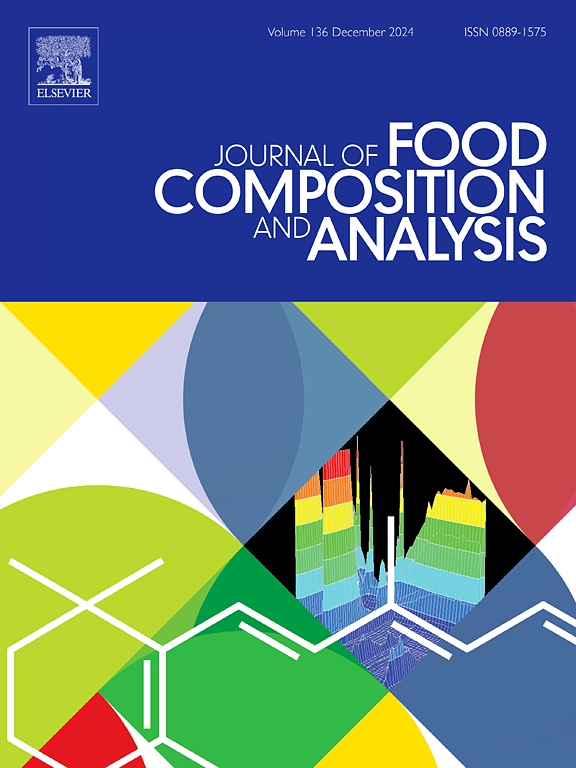Comparative analysis of the characteristics and content of γ-oryzanol in 19 Chinese brown rice cultivars
IF 4
2区 农林科学
Q2 CHEMISTRY, APPLIED
引用次数: 0
Abstract
The composition and content of γ-oryzanol significantly influenced its biological activity. The contents of γ-oryzanol in 19 Chinese brown rice (Oryza sativa L.) cultivars were quantified and characterized using high-performance liquid chromatography/mass spectrometry. The total content of γ-oryzanol in these 19 Chinese brown rice cultivars ranged from 19.37 to 232.2 mg/100 g, with an average of 76.23 mg/100 g. Five specific steryl ferulates were identified. Cycloartenyl ferulate, 24-methylene cycloartanyl ferulate, and β-sitosteryl ferulate comprised approximately 82 % of the total γ-oryzanol content, while campesteryl ferulate and stigmastanyl ferulate constituted the remaining 18 %. Japonica and glutinous rice exhibited similar γ-oryzanol contents, which were significantly different from those of indica rice. No significant difference was observed in the total γ-oryzanol content between the short-grain and long-grain rice. However, there were significant differences in the steryl ferulates. Both latitude and longitude significantly influenced the γ-oryzanol content, and longitude had a more pronounced effect than latitude. Apart from the lack of correlation between cycloartenyl ferulate and β-sitosteryl ferulate, significant correlations were observed among the contents of the other steryl ferulates. This study offers valuable insights to scientifically assess the nutritional value of Chinese brown rice, guide the breeding of varieties and inform high-quality cultivation practices.
γ-oryzanol的组成和含量对其生物活性有显著影响。采用高效液相色谱/质谱法对 19 个中国糙米品种中的γ-oryzanol含量进行了定量和定性分析。这 19 个中国糙米品种中的γ-oryzanol 总含量范围为 19.37 至 232.2 mg/100g,平均含量为 76.23 mg/100g。鉴定出了五种特定的甾基阿魏酸酯。环木菠萝烯基阿魏酸酯、24-亚甲基环木菠萝烯基阿魏酸酯和β-谷甾醇基阿魏酸酯约占γ-芳樟醇总含量的 82%,莰酯基阿魏酸酯和柱甾醇基阿魏酸酯占其余的 18%。粳稻和糯稻的γ-芳樟醇含量相似,但与籼稻有显著差异。短粒水稻和长粒水稻的总 γ -oryzanol 含量没有明显差异。但是,甾基阿魏酸含量有明显差异。纬度和经度对γ-oryzanol含量都有显著影响,且经度的影响比纬度更明显。除了环木菠萝烯阿魏酸酯和β-谷甾醇阿魏酸酯之间缺乏相关性外,其他甾醇阿魏酸酯的含量之间也存在明显的相关性。这项研究为科学评估中国糙米的营养价值、指导品种选育和优质栽培实践提供了宝贵的见解。
本文章由计算机程序翻译,如有差异,请以英文原文为准。
求助全文
约1分钟内获得全文
求助全文
来源期刊

Journal of Food Composition and Analysis
工程技术-食品科技
CiteScore
6.20
自引率
11.60%
发文量
601
审稿时长
53 days
期刊介绍:
The Journal of Food Composition and Analysis publishes manuscripts on scientific aspects of data on the chemical composition of human foods, with particular emphasis on actual data on composition of foods; analytical methods; studies on the manipulation, storage, distribution and use of food composition data; and studies on the statistics, use and distribution of such data and data systems. The Journal''s basis is nutrient composition, with increasing emphasis on bioactive non-nutrient and anti-nutrient components. Papers must provide sufficient description of the food samples, analytical methods, quality control procedures and statistical treatments of the data to permit the end users of the food composition data to evaluate the appropriateness of such data in their projects.
The Journal does not publish papers on: microbiological compounds; sensory quality; aromatics/volatiles in food and wine; essential oils; organoleptic characteristics of food; physical properties; or clinical papers and pharmacology-related papers.
 求助内容:
求助内容: 应助结果提醒方式:
应助结果提醒方式:


